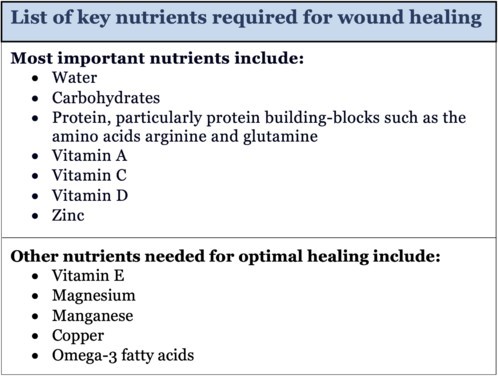A nurse is reinforcing teaching with a client who has an open leg wound and is experiencing difficulty healing. The nurse should encourage the client to increase which of the following nutrients in his diet?
Calcium
Protein
Vitamin D
Fats
The Correct Answer is B
Protein is essential for wound healing as it plays a crucial role in tissue repair and regeneration. It provides the building blocks for new tissue formation and helps in the synthesis of collagen, which is necessary for wound healing. Adequate protein intake promotes wound healing by supporting the growth of new cells, enhancing immune function, and aiding in the formation of new blood vessels.
Calcium is important for bone health but does not directly impact wound healing. However, a balanced diet that includes sources of calcium is generally recommended for overall health. Vitamin D plays a role in bone health and has some influence on immune function and wound healing. However, the primary focus in this scenario should be on protein intake.
Fats, specifically essential fatty acids, are necessary for overall health and immune function. However, increasing fats in the diet may not directly impact wound healing. It is important to consume a balanced diet that includes healthy fats, but the emphasis for wound healing is on protein intake.

Nursing Test Bank
Naxlex Comprehensive Predictor Exams
Related Questions
Correct Answer is D
Explanation
A. While monitoring oxygen saturation is important, ensuring an open airway takes priority.
B. Administering oxygen is important, but ensuring an open airway is the initial priority.
C. Checking the pulse rate is important, but ensuring an open airway is the initial priority.
D. Correct. Establishing a patent airway is the most critical action for a client with compromised breathing and cyanosis.
Correct Answer is D
Explanation
A. Restraining the child's upper extremities is not recommended during a seizure as it can cause injury.
B. Placing a padded tongue blade in the mouth can lead to injury and is not recommended during a seizure.
C. Turning the child onto their back is appropriate to ensure a clear airway, but it should be done gently without forcing movements.
D. Correct. Placing a pillow under the child's head helps protect their head from injury during the seizure.
Whether you are a student looking to ace your exams or a practicing nurse seeking to enhance your expertise , our nursing education contents will empower you with the confidence and competence to make a difference in the lives of patients and become a respected leader in the healthcare field.
Visit Naxlex, invest in your future and unlock endless possibilities with our unparalleled nursing education contents today
Report Wrong Answer on the Current Question
Do you disagree with the answer? If yes, what is your expected answer? Explain.
Kindly be descriptive with the issue you are facing.
